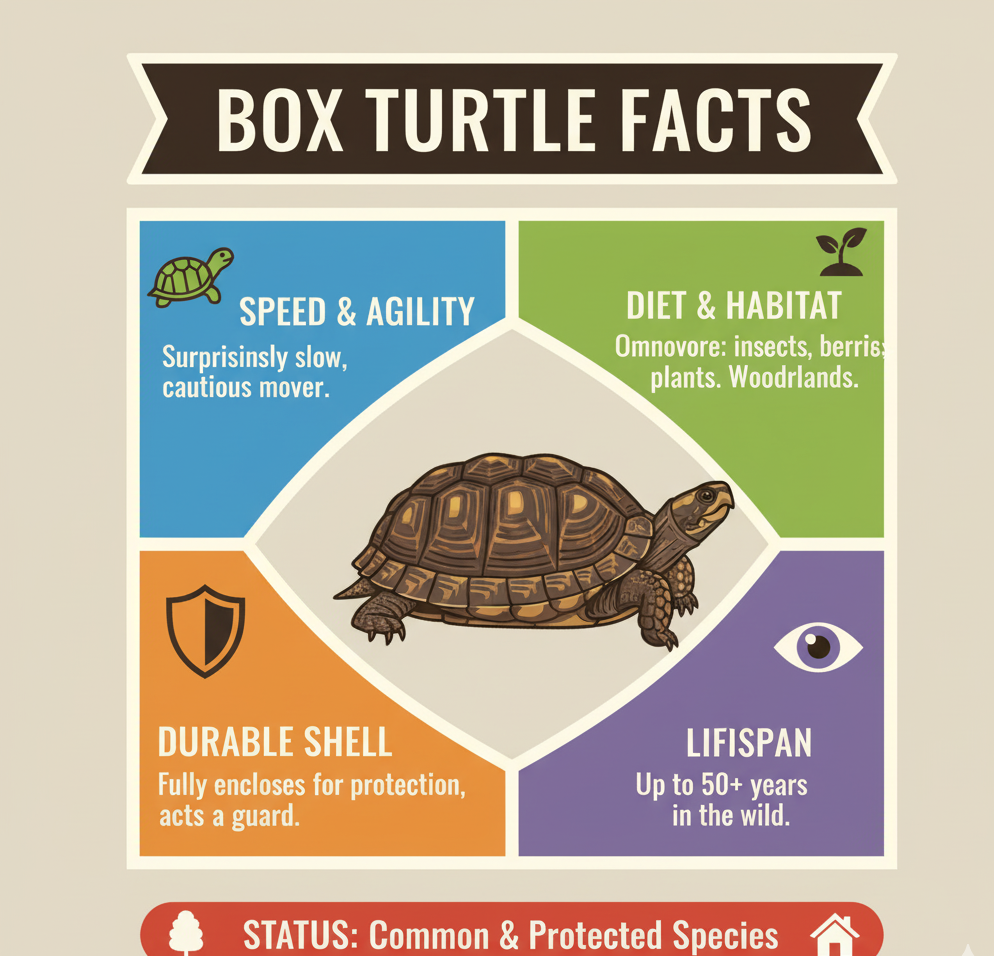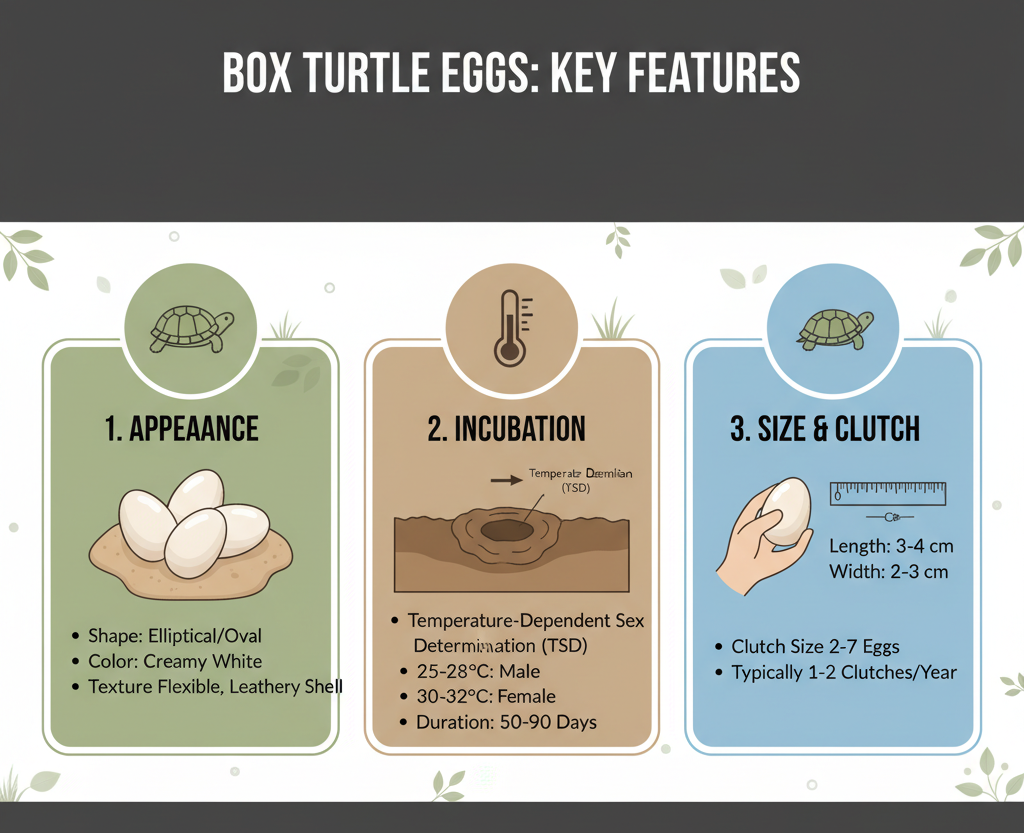
Box turtles are fascinating creatures with unique shell patterns. Their eggs are equally intriguing, requiring specific care and conditions to thrive. Understanding the needs of box turtle eggs is crucial for successful hatching.
These eggs are laid in sandy or soft soil, where they begin their journey to becoming hatchlings. The incubation period is a delicate time, influenced by temperature and humidity. Proper care during this stage is vital for the development of healthy turtles.
Hatching is an exciting process, but it requires patience and attention. Knowing what to expect can help ensure a smooth transition from egg to hatchling.
This guide provides essential information on box turtle eggs, from nesting to hatching. Whether you’re a turtle enthusiast or a pet owner, you’ll find valuable insights here.
Understanding Box Turtles and Their Eggs

Box turtles belong to the Emydidae family, famed for their distinctive appearance and behavior. These turtles thrive in freshwater habitats, such as ponds and rivers, and adapt well to various environments.
Their eggs are unique, with leathery shells rather than the hard shells of birds’ eggs. This soft texture demands careful handling to prevent any damage to the developing embryo. It’s essential to maintain the eggs in the same position as they were laid.
Key Features of Box Turtle Eggs:
- Oval and leathery texture
- Incubation period ranges from 60 to 90 days
- Sensitive to temperature changes
- Require stable humidity levels
Proper egg care involves managing both temperature and humidity. The sex of the hatchlings depends on the incubation temperature, making it a critical factor. Typically, temperatures between 82°F and 86°F are conducive to healthy development.
Recognizing the natural conditions of box turtles helps in providing appropriate care for their eggs. These turtles prefer to nest during warmer months, ensuring conditions are favorable for egg development. Understanding these details is crucial for anyone interested in turtle breeding or conservation.
The Nesting Process: How and Where Box Turtles Lay Eggs
Box turtles typically lay their eggs in sandy or soft soil environments. They select locations that offer both warmth and protection from predators. Finding a secure spot is crucial for the survival of their eggs.
Once a suitable site is identified, the female digs a nest with her hind legs. She creates a chamber deep enough to cover and protect the eggs from disturbances. The process is intricate and can take several hours to complete.
Key Points About Nesting:
- Eggs are laid in sandy or soft soil
- Nesting occurs during the warmer months
- Digging a nest is a slow, deliberate process
After laying, the mother covers the eggs with soil to camouflage them. This instinct helps in reducing the risk of predators discovering the nest. The nesting process underscores the turtles’ resilience and ability to adapt to their natural environments.
Incubation: Temperature, Humidity, and Egg Care Essentials
Proper incubation is crucial for the successful hatching of box turtle eggs. The incubation period usually ranges from 60 to 90 days. During this time, monitoring conditions like temperature and humidity is essential.
Temperature plays a pivotal role in the development and sex determination of the hatchlings. Ideal incubation temperatures generally fall between 82°F and 86°F (28°C to 30°C). Maintaining stable conditions is crucial, as fluctuations can significantly impact egg development.
Essential Incubation Conditions:
- Temperature: 82°F to 86°F (28°C to 30°C)
- Humidity: 70% to 80%
- Handling: Minimal to prevent embryo damage
Humidity is another key factor for egg care. The recommended level is around 70% to 80%, which helps ensure proper development of the shell and embryo. Using a substrate like vermiculite or perlite can help maintain optimal moisture levels.
Handling the eggs should be avoided to prevent damaging the delicate embryos. They should remain in the position they were placed to ensure the embryos develop correctly. Providing a stable environment is paramount for successful incubation.
Incubation conditions need regular checks for temperature and humidity stability. Any significant changes can impact the health and survival rate of the hatchlings.

Hatching Turtle Eggs: What to Expect and How to Help
As the incubation period comes to an end, signs of hatching may become visible. Observations such as the eggshell softening and the appearance of small cracks signal that hatching is imminent. It’s essential to monitor these changes closely.
Hatchlings use a special egg tooth, which eventually falls off, to break through the shell. This process, known as “pipping”, can take several hours to a few days. Patience is key during this stage, as rushing can harm the emerging turtles.
Key Indicators of Hatching:
- Shell softening and cracking
- Hatchlings using an egg tooth
- Slow and gradual emergence
To aid the hatchlings, ensure a stable and calm environment. Avoid unnecessary vibrations and disturbances that could stress the emerging turtles. It’s vital to let them arise naturally unless assistance is necessary.
After the hatchlings break free, they may remain partially in the egg, absorbing yolk for initial nourishment. This process provides essential nutrients crucial for early development. Once fully emerged, it’s vital to ensure they have a safe, shallow-water environment for them to explore.

Caring for Box Turtle Hatchlings
Once emerge, box turtle hatchlings are pretty independent, requiring minimal intervention. However, creating a suitable habitat is crucial for their survival and growth. A shallow water environment with easy access to land provides them the right balance between safety and exploration.
Hatchlings are particularly vulnerable to dehydration, so provide them with regular access to clean, fresh water. Proper water quality not only prevents dehydration but also supports their respiratory and skin health.
Essential Care Tips:
- Provide shallow water with land access
- Ensure a constant, clean water supply
- Monitor for health issues
Diet plays a significant role in their development. Offering a mix of protein and vegetables helps support their nutritional needs. Gradually introduce a varied diet to prevent digestive issues, focusing on a balance that mimics their natural preferences.
It’s also essential to create hiding spots in their habitat. These reduce stress and enable hatchlings to exhibit their natural behavior, which in turn supports their long-term well-being and survival. Attention to these details can significantly enhance the survival chances of young turtles.

Common Threats and Conservation Tips
Box turtle eggs face numerous threats in their natural environment. Predators, environmental changes, and human interference can drastically reduce hatch success rates. Protecting nesting sites is vital to ensuring the future of these unique turtles.
Conservation efforts focus on habitat preservation and reducing illegal poaching. Public education about their importance in ecosystems can also play a key role. Everyone can contribute to safeguarding these turtles by taking small but impactful actions.
Protective Measures Include:
- Supporting habitat conservation programs
- Following local wildlife regulations
- Reducing pollution in nesting areas
By actively participating in conservation initiatives and raising awareness, individuals can help mitigate these threats and support the growth of box turtle populations.
Common Questions About Box Turtle Eggs
What is the ideal incubation temperature?
The ideal incubation temperature for box turtle eggs typically falls between 82°F and 86°F (28°C and 30°C). This temperature range is crucial for proper embryo development and can also influence the sex of the hatchlings.
How long does the incubation process take?
The incubation period for box turtle eggs usually ranges from 60 to 90 days. This duration can vary based on environmental conditions, primarily temperature and humidity.
Are hatchlings independent after hatching?
Yes, once hatchlings emerge from their eggs, they are pretty independent and require minimal intervention. However, it’s essential to provide a suitable habitat with access to shallow water and land to support their growth and well-being.










